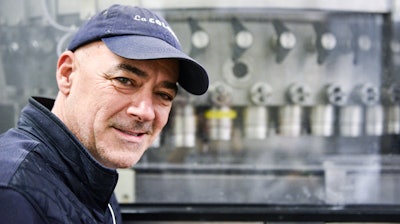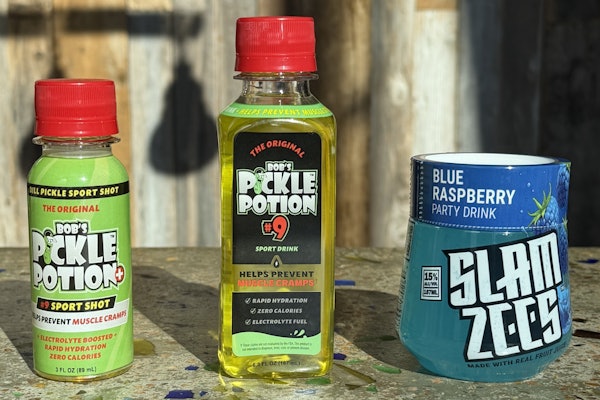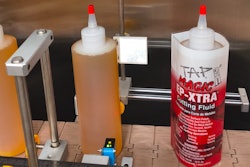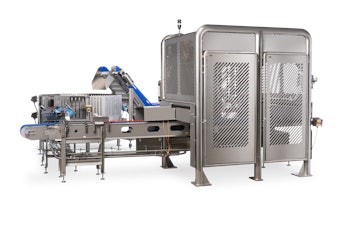
Todd Carmichael, President of La Colombe coffee, is a successful entrepreneur, a TV personality, a world adventurer, and a bit of a mad scientist. Carmichael’s enthusiasm is palpable as he works to democratize coffee and bring innovation to the category. His latest invention: a new ready-to-drink, nitrous oxide-infused Draft Latte that not only is the first texturized coffee product, but also boasts a surfeit of packaging firsts.
For one, La Colombe is the first to put a hole in a beverage can—on purpose. Also a first for coffee is the can’s glossy sleeve label and custom-designed “sip-through lip guard.” La Colombe is also the first coffee company to own its own dairy production facility, and its packaging equipment—much of which is from well-known suppliers—has been re-engineered specifically for the product. La Colombe is also most likely the first coffee company to use a gasser shaker, a machine typically used in aerosol filling. And, the Draft Latte is the first nitrous oxide-infused beverage packaged in a can with a hole to go through the retort process.
Carmichael, who began La Colombe in May 1994 with partner JP Iberti, has visited nearly half the world’s countries, has crossed large parts of the Sahara, Gobi, Namib, and other deserts on foot, and is the first American to solo trek across Antarctica from the coast to the South Pole, establishing a world-record speed in the process. Even so, Carmichael admits that creating the Draft Latte was one of the most difficult challenges he’s faced.
“It was hard to convince professionals that a product in a package like this was possible. They looked at me like I was a crazy person,” Carmichael says. “So, the biggest hurdles were pretty much every R&D department I encountered.”
Liberating crafted coffee from the coffee bar
Carmichael and Iberti began La Colombe with the premise that “America Deserves Better Coffee.” To achieve this, they focused on responsibly sourcing their coffee beans and roasting them with care, and borrowing on ancient and modern coffee traditions from around the world. They progressed from operating cafes—they have nearly 30 nationwide now—to supplying the hospitality industry, and now to retail.
La Colombe began innovating around cold coffee in 2009 when they saw it was becoming a big trend in cafes. “Then I realized that was just the beginning,” says Carmichael. “If you’re going to go cold, you’ve got to have the whole menu,” meaning cold espresso and cold latte cappuccino drinks. With the popularity of La Colombe’s on-tap cold latte at its cafes, Carmichael began brainstorming about how to create the frothed milk and cold-pressed espresso beverage in an RTD format, while preserving its taste and texture, to make the premium-quality beverage more mobile.
“The winds are always moving from anchor to mobile,” he says. “Twenty years ago, you would stand in line to cash a check, right? But you don’t do that anymore. But we stand in line twice a day to get our coffee. At La Colombe, we felt we needed to look critically at our processes and our packaging to liberate crafted coffee from the coffee bar. Now, I say that, even though we have almost 30 cafes, and we’re building a dozen more. But they are not going away, just like bars didn’t go away when we learned how to put beer in a bottle, because it’s such a social experience. But now I can have access to beer in my fridge at any time.”
When Carmichael began looking in earnest at creating an RTD latte product in 2014, there were some RTD nitro-coffee products on the market. But using nitrogen was not going to give Carmichael the results he wanted. “You force the nitrogen into the fluid, and then when you open the can, it rushes out,” he says. “It wants to go back into space. It’s an effect; it doesn’t have any substance to it. It’s a novelty for a couple of reasons. It doesn’t alter the flavor. It’s temporary—it’s all over with in about 10 seconds. And ultimately, people don’t drink cold coffee from the top; they drink it from the bottom. You have a lid and a straw. It’s how people drink.”
In order for Carmichael to put the La Colombe name on the product, the beverage had to deliver on its promise: a texturized coffee drink with the same taste and froth as the one consumers could buy at a La Colombe café. To achieve the texture, Carmichael came up with the idea of dosing the beverage with nitrous oxide—a gas commonly used for whipped cream—through the bottom of the can, and then shaking the can to disperse the gas throughout the coffee. For the taste, La Colombe uses the highest-quality, real ingredients, including fresh milk, rather than powdered or rehydrated milk, and cold-press espresso. The drink also packs a full-on caffeine punch, with 115 mg of natural caffeine, equal to one and a half cups of coffee. There are four varieties available: Latte, Triple Latte, Vanilla, and Mocha.
New can manufacturing process
At the start of the project, La Colombe made its own cans, taking a can body, punching a proprietary-shaped hole in the bottom, flipping it, and inserting a grommet. Having this prototype, Carmichael says, helped him convince suppliers that it could be done. “What I was asking these people to do is something they’ve been trying to avoid since the start of their company, and that is, put a hole in the can,” he says. “And it can’t be any old hole.”
In 2015, Carmichael approached Crown about the project. Explains Dr. Daniel Abramowicz, Executive Vice President Technology & Regulatory Affairs for Crown Holdings, “Todd came to Crown because he envisioned the Draft Latte marrying aerosol can and beverage can technology, and Crown has expertise in both markets. We were bullish about the concept and our ability to deliver what was needed. And when we tasted the product, we were ‘in.’”
The process of inserting a grommet or valve in the bottom of a can was not new. However, it had only been done with three-piece aerosol cans, with the valve inserted into the flat bottom component of the can. For the Draft Latte, Crown needed to use a two-piece beverage can with an integrated one-piece can body and a domed can bottom.
“One challenge was effectively piercing and inserting the grommet into a fully formed beverage can compared to the relatively flat bottom component of the three-piece aerosol can,” Dr. Abramowicz explains. To accomplish this involved the design of a new can manufacturing process and new equipment.
The result is a proprietary design with a one-way valve called the InnoValve® can. The chimney-like valve allows the nitrous oxide to be injected into the bottom of the can, while ensuring the integrity of the coffee beverage. When the gas is injected, it dissolves into the milk fats in the latte the same way it does in whipped cream. Explains Dr. Abramowicz, “When the consumer opens the package and releases the pressure in the container, the gas generates the creamy texture that defines these products.”
Given the strong collaboration between La Colombe and Crown in developing the valved can, Crown has provided La Colombe with exclusive rights to the InnoValve container for the textured beverage market for a predetermined period. However, Crown has reserved the right to use the InnoValve can for other product applications.
Up and running in 120 days
Originally, La Colombe’s RTD Draft Latte was produced and packaged in a small plant in Pennsylvania. In March 2016, the company launched its first run of 10,000 cans on Amazon.com. Within 60 minutes, the product was sold out. Realizing La Colombe had a hit on its hands, Carmichael frantically began searching for a plant with greater capacity. He had three requirements for a production facility: cows—“lots and lots of cows”—with the farmers located nearby, talent, and an existing building. He found them all at a former dairy plant in Norton Shores, MI, which he purchased in August 2016.
Within 120 days of the purchase, La Colombe’s RTD Draft Latte production and packaging plant was up and running. The 55,000-sq-ft facility houses one packaging line, with room for two more. Much of the equipment was customized by Carmichael and his team to handle the unique requirements of the product and package.
For the filler, La Colombe had to look outside of the U.S. for a machine that could handle a 9-oz can. Then, the filler, from Pneumatic Scale Angelus, had to be tweaked to fill the can with 8 oz, rather than nine, to allow for necessary headspace. “When you open the can, you have to give the beverage space to rise, and fillers aren’t made to do that,” says Carmichael. “So myself and a couple of the team members would just literally sleep in here, we would pull the filling heads apart. There’s a metal smith nearby, so we’d run over and try this, run it back, and then finally, we cracked the code.”
The can is filled using the Angelus SEN HW 60 rotary filler, after which it is seamed on an integrated Angelus 120L. A Filtec inspection system is next in line, checking the fill level on each can.
The plant uses three Aerofill gasser/shakers from R.A. Jones that add the nitrous oxide to the can while agitating the product to dissolve the gas in the fluid. After this step, the cans are accumulated into carts and rolled into a batch retort from JBT FoodTech that pasteurizes the milk-based coffee drink at a temperature of 250º F for a 180-day shelf life.
Sleeve labels are applied using a Fuji Seal International labeler. The can’s valve and lip guards are added manually, at a speed of 100/min. Finished product is hand-packed into four-count cartons, with the front of each can facing outward through the carton’s die-cut panels. Cartons are then manually stacked on pallets.
While Carmichael says the last few steps in the process could be automated, he is committed to retaining the human touch with each product. “If you were to walk with me around our roasting plant [in Philadelphia], you would see that everything has to be touched,” he says. “It’s important that there be a human being at some juncture, because of the feedback loop. Humans are really good at catching things, like, ‘this sleeve is wrong, this sleeve is right.’”
There are 62 employees at the Norton Shores plant, and as La Colombe adds more packaging lines, Carmichael says operators will be redeployed in other areas. “I could have a four-pack cartoner here in two weeks,” he says, “but I don’t want to take anyone’s job.”
Democratizing coffee
As of February 2017, when Packaging World visited the Norton Shores plant, the packaging line was humming along at speeds to 4,000 cans/hr, operating two shifts per day. But with the canned beverage now available in thousands of stores nationwide, including grocery, convenience, club, and natural food stores, as well as at the company’s cafes, La Colombe may soon have to expand its operations.
According to Carmichael, the plant can accommodate three lines that, when fully operational over three shifts, will be able to produce a quarter billion cans per year. And that suits him just fine, as Carmichael’s dream is “to make coffee for everyone in the United States of America.”
“Every generation or so, someone comes along and changes the way America interacts with its coffee,” he says. “In the ’70s, Mr. Coffee came along and replaced the percolator with an automatic-drip brewer. In 1980, there was the instant coffee guy. Then there was the vacuum can. Then there was this K-cup guy. And this is going to keep going forever. My life’s work, and my dream really, is to have La Colombe be that agent of change.
“There’s this weird politicization of coffee. If you work with your hands, you should get your coffee from a gas station. Or if you work in a law firm, you get your coffee from a branded coffee shop. Why is that?
“Coffee, when done right, is the ultimate democratic luxury. Everyone is within reach of the very best in the world. And I think that’s a big part of what La Colombe is about and what we are doing here.”
Attention to detail extends to can
With the same care it took to secure the freshest ingredients and ensure its Draft Latte tastes the same as the one served at its cafés, La Colombe spent a year developing the aesthetics and sensory appeal of the packaging for the latte line. From top to bottom, every aspect was considered.
Beginning with the bottom of the package, Carmichael designed an injection-molded polypropylene disk—the “valve guard”—that is glued to the bottom of the can to cover the valve and the aluminum end for a clean, premium appearance.
Carmichael says he chose the 9-oz can profile—larger than an energy drink can, smaller than a soda or beer can—with a slight shoulder, to set the coffee beverage apart. The can is also unique in its choice of decoration: a glossy full-body, shrink-sleeve label from Fuji Seal International. Carmichael opted for the sleeve label rather than direct print not only for its appearance, but also its tactility. “When you touch aluminum, the experience isn’t that great,” he says. “But when you put this sleeve over it, the tactile experience is beautiful.”
Decorating the can with a sleeve label also gives La Colombe the option to create new labels for limited-edition flavors or seasonal packaging. Because he likes to constantly “tweak, tweak, tweak,” Carmichael says he orders labels in runs of one million at a time. With direct-print cans, minimum-order quantities are far larger.
In terms of graphics, the labels use a minimalist design: a clean white background, bands of color to differentiate flavors, and a list of core ingredients. Also featured is the La Colombe logo—a dove—inspired by Picasso’s “Dove of Peace” drawing. (La Colombe, translated from French, means “the dove.”)
Aside from the gorgeous glossy label, the other most striking feature of the can is what La Colombe calls a sip-through lip guard. A round PP piece covering the top of the can, the lip guard has a cutout on one side for the tab and a half moon-shape cutout over the drinking hole. Carmichael says the lip guard elevates the experience of drinking from an aluminum can: “Your lips are just packed with nerves, and when you put your lips on something, there is communication; there is a message going on there. When you drink from an aluminum can, it communicates a beer or soda. So, you prepare for that. What I wanted to do was intercept that, put something in-between it, and change that experience.” The lip guard also directs the cold coffee beverage onto the tongue in the same way a straw would.
Carmichael worked with The Flexcraft Co. to design the injection-molded lip guard. “We did a 3D prototype and just snapped it on,” says Carmichael. “I loved it, and I said, ‘let’s go!’”
Aesthetic considerations didn’t end with the can. A four-pack carton for the Draft Latte is die-cut on four sides, providing transparency to the product and allowing it to be seen from all four sides. It also ensures that the carton is always facing forward on-shelf. “Things have to look beautiful on their own,” says Carmichael, “but they also have to look beautiful together.”




























